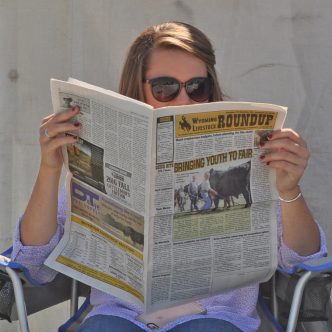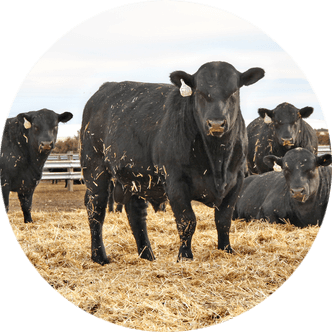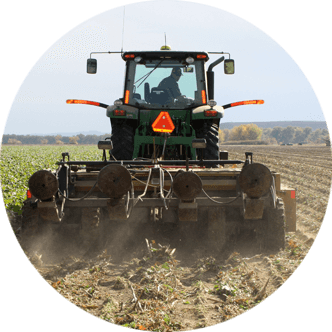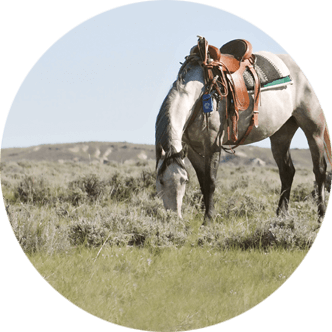Wyoming sheep and wool producers offer insight during sheepherder panel
Five Wyoming sheep and wool producers offered comments on the state’s sheep industry during a panel discussion at the 2025 Wyoming Sheep and Wool Festival, held July 11-13 in Buffalo.
The discussion covered a variety of topics regarding the past, present and future of the Wyoming sheep and wool industry and was facilitated by University of Wyoming (UW) Extension, Agriculture and Natural Resources Educator Micah Most.
Panel highlights
Panelists included Campbell County Sheep Producers Bob Innes and Kelly Barlow, Johnson County Sheep Producers Kirby Camino and Mike Curuchet and Karen Hostetler, owner of Mountain Meadow Wool Mill in Buffalo.
The conversation began with panelists sharing a bit about their operations, from how they got their start to current day-to-day methods. Across the range of comments shared, a common theme was community and continued learning.
Curuchet, Camino and Innes all come from multiple generations of Wyoming sheep producers. Throughout the panel, they shared stories and examples of how their operations have changed over the years, crediting wisdom from previous generations coupled with hands-on experience as factors in their continued success.
“My grandparents came over from the Basque country and raised sheep when they got here,” Curuchet stated.
“My dad carried it on, so I was born into it. I learned a lot from my dad and some other good sheep people around us. You pick up something from any operation you go to. We help each other on the mountains all the time,” he added.
Camino echoed Curuchet’s sentiments, crediting experience as the best teacher.
“You learn from people who lead by example,” Camino began. “You try things and if it doesn’t work, you don’t do it again. If it works, you keep trying it. If there’s a different way to make it work better, do it. Always try and stay progressive.”
“There’s no substitute for experience,” Innes said. “Every day and every year there are new things to learn. You have to pay attention and never think you already know it all.”
Innes further remarked on technological advancements as a big aid to the evolution of his operation, which began with his grandfather raising Panamas in the 1930s and has evolved into a predominately Targhee herd. He specifically noted National Sheep Improvement Program technology and surveillance cameras in lambing sheds as tools in maintaining his herd.
Hostetler and Barlow got their start in the sheep industry more recently, but still echoed sentiments about community and continued learning.
Hostetler shared the Mountain Meadow Wool Mill got its start 18 years ago with the help of 10,000 pounds of wool provided by the Camino family. This business partnership has continued to this day and developed into working with several ranching families in the surrounding area.
As stated on the Mountain Meadow Wool website, the mill is “dedicated to quality and sustainability” and “produces 100 percent American-made, Wyoming-grown wool crafted with eco-friendly practices and fair prices for ranchers.”
Hostetler noted the mill’s goal is to “make a brand identity for Wyoming wool” and contribute to the continuation of the ranching lifestyle.
Barlow runs Dorper sheep with her husband Eric and their children and markets lamb directly to consumers. After some initial learning curves, Barlow said she grew to love working with sheep and producing lamb.
“I love seeing the herd grow,” Barlow said. “It gives me a pride in what I’m doing and the food we’re providing for the world.”
Current challenges
In addition to sharing background information about their operations, panelists discussed current issues facing the sheep and wool industry. Lack of interest in the labor force, increased predator numbers, unpredictable weather and current market conditions were predominant themes.
Camino mentioned fire and drought conditions prevented use of regular lambing pasture on his operation, leading to an unhappy herd and more labor spent rounding up escaped sheep and repairing fences.
Camino said, “Mother Nature threw us a big challenge with the fire, but we adapted and did the best we could with what we were dealt.”
Hostetler noted the wool mill faces challenges with market conditions and labor force. She explained wool marketing has changed drastically in the past two decades and highlighted the challenge of making sure enough product gets sold in the face of changing conditions.
Hostetler further noted every employee has to be trained from the ground up on how to spin yarn, and help is sometimes in short supply.
“It’s not really a skill you can advertise for,” she noted. “We have some employees who will be with us forever because they love the work, but we have a lot who come and go. Every single employee who comes in has to be trained for the specific job.”
Barlow made note of the challenges involved with marketing lamb to consumers she’s experienced throughout the years, as well as operational challenges posed by lack of willing or available help.
“Everyone is just going in so many different directions now,” Barlow remarked. “It’s a lot of work getting the next generation to be willing to work this hard sometimes.”
Innes and Curuchet both noted predator control, specifically coyotes, as a big challenge which has increased in recent years.
“We used to be in a coyote-free zone – 100 percent control,” Innes said. “Now, we spend so much time, money and resources trying to control coyotes or watch for them and see if we have any impacts.”
Curuchet echoed Innes’ statements and also made note of rising production demands, in addition to the rising costs of labor and land putting a strain on some aspects of operation.
“On our operation, the biggest thing that’s changed over the years is the demand for more production,” Curuchet said. “The markets have demanded more, and everybody’s production has gone up so much.”
Hope for the future
To close out the conversation, panelists shared their thoughts on the future of the sheep and wool industry.
Comments were cautiously optimistic, noting current market conditions as a point of difficulty but also highlighting a generational attitude of dedication and perseverance shared by sheep producers as a point of hope.
“What’s kept this industry going for so long is the people involved,” Innes said. “Sheep people are a bunch of superstars and have been for generations. They’ve risen to the occasion and challenge time after time.”
“The sheep is a pretty unique, miraculous creature in itself to take a clump of grass and convert it to wool and lamb,” Innes continued.
Barlow remarked on the involvement of 4-H and FFA youth as a point of hope.
“It’s hard work, sun up to sun down, so seeing youth who are willing to do it gives me hope,” Barlow said. “This is one of the reasons I stay involved with supporting 4-H, FFA and our county fair, to encourage and help boost it along.”
Camino’s comments also pointed to the next generation.
“For me, it goes back to my kids,” Camino said. “When my six-year-old asks some really tough questions in the shed, it reminds me that little sponge is retaining everything he might need to do what we do. It gives me hope there’s still somebody interested in taking over the family business.”
“I think events like this give me hope,” said Hostetler in closing. “I see faces of people in the audience, and those who are up here, who have spent their whole life raising sheep and living the ranching lifestyle. I believe it’s something future generations are going to want to continue. I think it’s engrained in us as human beings, so it gives me hope.”
Grace Skavdahl is the editor of the Wyoming Livestock Roundup. Send comments on this article to roundup@wylr.net.





